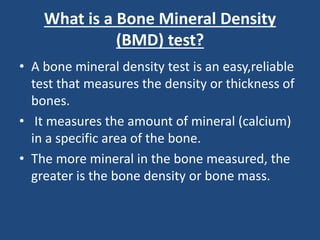Bone density is within 1 SD 1 or 1 of the young adult mean. Bone mineral density studies are used to evaluate diseases of bone andor the responses of bone diseases to treatment.
Bone mineral density.

. A bone density test is used to measure bone mineral content and density. Bone mineral density measurements are used to diagnose osteoporosis a. Patients were included in an observational prospective follow-up study.
Your risk for breaking bones. Whether your osteoporosis treatment is working. Dynamic loading during gymnastics has been show to affect bone size and strength.
Intervertebral discs were assessed for degeneration by. Victoria Chatzimavridou Grigoriadou MD and Claire Emily Higham MBBS DPHI. Bone mass density Osteopenia Osteoporosis.
Dual energy x ray absorptiometry DXA scans to measure bone mineral density BMD at the spine and hip have an important role in the evaluation of individuals at risk of osteoporosis and in helping clinicians advise patients about the appropriate use of antifracture treatment. We sought to estimate the prevalence of reduced bone mass defined by lumbar spine bone mineral density LS-BMD z-score -20 and to determine the factors associated with LS-BMD after liver transplantation in children and adolescents. Forearm BMD should be measured under the following circumstances.
Osteopenia is defined as a low ____. It compares your bone density or mass to that of a healthy person who is the same age and sex as you are. A cross-sectional medical survey was.
The impact of bone mineral density and disc degeneration on shear strength and stiffness of the lumbar spine following laminectomy. The studies access bone mass or density associated with such diseases as osteoporosis osteomalacia and renal osteodystrophy. The prevalence and predictive factors for hepatic osteopenia and osteoporosis posttransplant bo.
A bone mineral density BMD test is the best way to measure your bone health. LS-BMD z-scores were measured in a sample of subjects who had undergone liver transplantation in childhood or adolescence using. Forms the dense compact outer shell of all bones as well as the shafts of the.
Bone density is more than 25 SD below the young adult. The skeleton serves the following purposes--cortical. Fracturing after liver transplantation OLT occurs due to the combination of preexisting low bone mineral density BMD and early posttransplant bone loss the risk factors for which are poorly defined.
A non-invasive test to measure the density of bone mineral which allows for an early diagnosis of osteoporosis or to monitor the effects of certain medications of bone Chemotherapy. A condition of reduced bone mineral density that predisposes the individual to fractures is called _____. The child or adults age height and degree of physical maturity are important factors inmeasuring and unders tanding bone mineral density BMD.
When information about bone mineral density is combined. A clinical condition characterized by low bone mass and an increased susceptibility to fractures. Presence of other risks for bone loss or fragility fracture.
Whether you have osteoporosis a disease that makes your bones weak. The condition characterized by a bone mineral density more than 25 SD below the young adult mean is called A. The basic idea is that heavier bones will be stronger bones.
Two factors-density and quality. Irregular or absent menstruation results in a loss of bone mineral density and is associated with a greater incidence of lower leg stress fractures in distance runners. The 2 basic types of bone.
Bone density refers to theratio of weight to the volume or area of the bones. RRIFs can also occur. It can also predict fracture risk.
Bone mineral density testing intervals should be individualized based on each patients clinical. BMD a measure of bone density reflecting the strength of bones as represented by calcium content. A measure of the amount of minerals mostly calcium and phosphorous contained in a certain volume of bone.
Osteoporosis is a common finding following chronic obstructive pulmonary disease COPD but there are few reports on the relationship between bone mineral density BMD and the syndrome types described in traditional Chinese medicine TCM in patients with COPD. Hip andor spine cannot be measured or interpreted. Bone Mineral Density Assessment Following Radiotherapy Related Insufficiency Fractures RRIFs of the Pelvis.
It may be done using X-rays dual-energy X-ray absorptiometry DEXA or DXA or a special CT scan that uses computer software to determine bone density of the hip or spine. The art and science of measuring the bone mineral content and bone mineral density of specific skeletal sites or the entire body. Lifelong struggle with abnormal eating patterns.
Most patients did not have osteoporosis at the time of RRIF and overall had low fragility fracture risk as defined by FRAX. A T-score within 1 SD 1 or. It seems that bone loss occurs after ACL rupture.
BMD was assessed by dual X-ray absorptiometry DXA. Bone density is between 1 and 25 SD below the young adult mean 1 to 25 SD. Osteoporosis is defined by A bone mineral density below -25 SD of the young adult mean.
Bone density is 25 SD or more below the young adult mean 25 SD or lower. The purpose of our study was to determine bone mineral density BMD changes in the knee after ACL rupture during 2-year follow-up period and to compare BMD changes between the injured and healthy contralateral knee. Compared with alternative bone densitometry techniques hip and spine DXA.
Osteopenia This is defined by a bone mineral density between -1 and -25 standard deviations SD of the young adult mean. The BMD test detects osteopenia mild bone loss usually without symptoms and osteoporosis more severe bone loss which may cause symptoms. Low BMD was defined as a BMD value below the median.
Bone mineral density BMD is defined as the amount of mineral calcium hydroxyapatite per unit of bone and can be used as an indirect indicator of bone strengthThe bone mineral density is used to determine if osteopenia or osteoporosis are present. Which of the following terms is defined as deformation divided by original length. Bone mineral density can be measured by various methods with DEXA.
Osteoporosis is defined based on the following bone density levels. Equally divided within the group of ten spines. Low bone density as defined by current ISCD guidelines.

Bone Mineral Density In Grams Per Cubic Centimeter Changes Associated Download Scientific Diagram

Indications For Bone Mineral Density Testing 8 Download Scientific Diagram

Indications For Bone Mineral Density Testing 8 Download Scientific Diagram

Bone Mineral Density What Is A Bone Mineral Density Test Ppt Video Online Download

Bone Mineral Density An Overview Sciencedirect Topics

Total And Regional Bone Mineral Density Bmd Percentage Fat Fat Mass Download Table

Interpretation Of Bone Mineral Density Ppt Download

Bone Mineral Density T Score A Download Table

Bone Mineral Density What Is A Bone Mineral Density Test Ppt Video Online Download

0 Comments